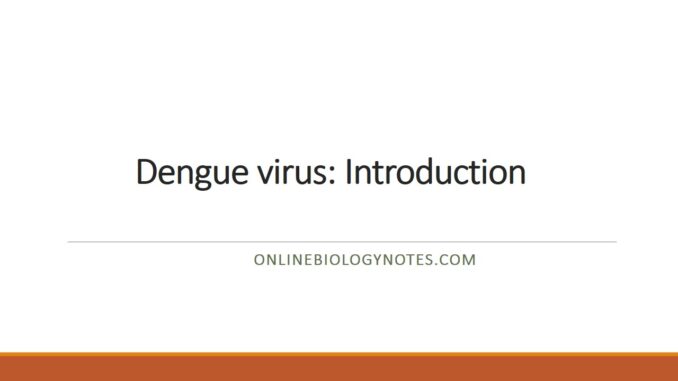
Dengue: Introduction
- Dengue viruses (DENV) is a mosquito borne viruses, belongs to the family Flaviviridae, the genus Flavivirus.
- Dengue viruses consist of five serotype named dengue virus types 1, 2, 3, 4 and 5 (DENV-1, -2, -3, -4 and -5), that are responsible for diseases.
- These serotypes are closely related but antigenically distinct.
- DENV-5 is a new serotype which has recently been described from Malaysia.
- Hotta and Kimura were the first to isolate the virus in 1943, by intracranial inoculation of serum from an acutely ill patient into suckling mice.
Morphology of Dengue virus:
- Dengue virus is spherical enveloped viruses with single-protein capsids, two membrane proteins, envelope and membrane.
- It has a single-stranded Positive-sense RNA genome of ~10,700 nucleotides, surrounded by a nucleocapsid and covered by a lipid envelope that contains the viral glycoproteins.
- The RNA genome lacks poly A tail at 3’end and contains a single open reading frame (ORF) flanked by two untranslated regions (5’ and 3’UTRs).
- The 5’ and 3’ terminal RNA sequences of the genome form large stem loop structures known as stem loop A (SLA) and 3’ stem loop (3’ SL) respectively, both essential for viral replication.
- The single ORF encodes a precursor polyprotein, which is co- and post-translational cleavage resulting in the formation of three structural proteins, Capsid (C), membrane (M), and envelope (E), and seven non-structural proteins, NS1, NS2a, NS2b, NS3, NS4a, NS4b, and NS5. NS2B and NS3 form the proteases, and NS3 also has helicase and RNA triphosphate activity; NS5 is the RNA dependent RNA polymerase and also has methyltransferase activity.
- It has four serotypes, DEN-1, DEN- 2, DEN-3 and DEN-4, which are capable of causing dengue fever (DF).
Pathology and clinical features of Dengue:
- Dengue is an acute infectious vector borne disease caused by dengue viruses and transmitted to human by the Aedes species, primarily by Aedes aegypti.
- The prevalence of dengue viral infection has been estimated that over 2.5 billion people live in the areas of risk with an incidence of 50-100 million cases per year and several thousands of deaths are estimated to occur annually worldwide, resulting in 500,000 cases of DHF/DSS and 25,000 deaths.
- Dengue virus induces clinical illness ranging from asymptomatic or mild febrile illness, i.e., Dengue Fever (DF) to severe disease forms, i.e., Dengue Haemorrhagic Fever (DHF) and Dengue Shock Syndrome (DSS).
- Infection with any one of the four DENV serotypes has the potential to involve all human organ systems and cause a wide variety of clinical manifestations ranging from mild febrile illness to severe and fatal disease.
- Symptomatic dengue disease is separated into two different clinical syndromes, dengue fever (DF), and the more severe dengue hemorrhagic fever (DHF); DF was described as a nonspecific febrile illness with prominent constitutional symptoms, while DHF was defined as a distinct syndrome characterized by increased vascular permeability, altered hemostasis and hemorrhage. DF is also referred to as the ‘break bone’ disease due to its nature of severe joint and muscular pain.
- Following an infectious mosquito bite there is an incubation period of up to 2 weeks (commonly 5-7 days), after which the individual develops symptoms suddenly and the illness typically follows three phases- an initial febrile phase, a critical phase starts 4-5 days from fever onset, followed by a spontaneous recovery phase.
- In febrile phase, patient experiences sudden onset of high fever (39-40°c) accompanied by nonspecific constitutional symptoms including headache, general malaise, nausea, vomiting, myalgia, and joint pain.
- In recovery phase, the increased vascular permeability and abnormal hemostasis are transient and usually resolve within 48-72 hours. Spontaneous reabsorption of fluid starts around 6-8 day of illness and progress rapidly, usually concurrent with improvement in the patient’s symptoms. Loss of hair has been reported during convalescence.
Primary infection:
- Primary infection with dengue virus results in a self-limiting disease characterized by mild to high fever lasting 3 to 7 days, severe headache with pain behind the eyes, muscle and joint pain, and a rash.
- Complications often occur within two days after the fall in temperature. Epistaxis, bleeding of gums, passage of black stools, rashes (petechiae, maculopapular, bruises, etc.) and sub-conjunctival hemorrhage are indicators of increasing disease severity.
- A maculopapular rash usually appears 3 – 4 days after the onset of fever. Secondary infection with a different dengue virus serotype is the more common form of the disease in many parts of Southeast Asia and South America.
- The major clinical symptoms can include high fever, hemorrhagic events, and circulatory failure, and the fatality rate can be as high as 30%. Early diagnosis of dengue shock syndrome is particularly important, as patients may die within 12 to 24 hr if appropriate treatment is not administered.
The major host factors that influence clinical manifestations are:
• Age: constitutional symptoms become more prominent with increasing age, that adults complain of headache, retro-orbital pain, and severe myalgia and arthralgia more frequently than children.
• Gender: Females have a lower threshold for vascular leakage than males. Although dengue is diagnosed more frequently in male than female patients, female patients have a higher risk of developing DSS and of dying from this complication than male patients [34].
• Pregnancy and transplacental infection: With the increasing burden of dengue seen among young adults, exposure to infection during pregnancy is becoming more frequent.
- Clinical findings alone are not sufficient to make an accurate diagnosis of DENV as several other infectious diseases may present with similar findings, which requires the need for laboratory testing for the dengue confirmation.
- Leucopenia, thrombocytopenia, increased hematocrit and liver enzyme levels are common laboratory findings suggestive of DENV infection.
- Serological tests, such as rapid diagnostic test (RDT), Enzyme-linked immunosorbent assay (ELISA) are widely used.
- In Nepal, serological testing has been used as an important tool for diagnosis of suspected DENV infection during outbreaks.
